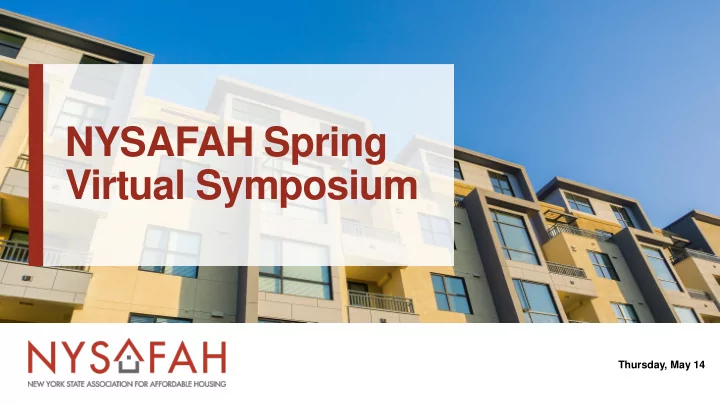

NYSAFAH Spring Virtual Symposium Thursday, May 14
Deborah VanAmerongen David Gasson Nixon Peabody Boston Capital 212-940-3054 617-624-8896 dvanamerongen@nixonpeabody.com DGasson@bostoncapital.com Robert Moss Emily Cadik CohnReznick Affordable Housing Tax Credit Coalition 617-648-1400 832-515-9975 Bob.moss@cohnreznick.com emily.cadik@taxcreditcoalition.org
Stimulus Funding for Rental Assistance Tenant-Based Rental Assistance Project-Based Rental Assistance $1.25 billion $1 billion These funds will preserve Section 8 voucher This additional funding will make up for rental assistance for seniors, the disabled, reduced tenant payments as a result of and low-income working families who will coronavirus. Preserving this critical housing experience loss of income from the assistance will prevent low-income families coronavirus. and individuals from being at risk of homelessness. For more information on this topic, please see Nixon Peabody’s alert: Housing related provisions in “Phase 3” coronavirus stimulus 3
Federal Mortgage Forbearance — Up to three 30-day requests, 90-day total — A federally backed multifamily mortgage loan (FannieMae; Freddie Mac; or FHA-insured, guaranteed, supplemented, or assisted in any way, by any officer or agency of the federal government, HUD, or ”related program administered by any other such officer”) Mortgage must have been current as of February 1, 2020 Oral or written request — HUD Multifamily can use MBA Forbearance Agreement — Owner must be experiencing a financial hardship during the COVID – 19 emergency — — Authority from March 27, 2020, and sooner; end of emergency as declared by the president; or December 31, 2020 — Eviction moratorium provision tied to forbearance (forbearance period plus 30 days) is similar, but doesn’t match up exactly with the eviction protections in the law 4
Federal Eviction Moratorium Eviction moratorium of 120 days starting March 27, 2020, and runs through July 24 — plus 30 days' notice. Prohibits noticing or filing for eviction for nonpayment of rent and prohibits assessing penalties/fees. Applies to: — Tenants with or without leases — In occupancy in a covered property — Condos and coops — Direct, insured, guaranteed, supplemented, assisted in any way — FHA — Fannie, Freddie — Rural Housing Vouchers — VAWA 5
Federal Eviction Moratorium (cont’d) VAWA Programs: — Section 221(d)(3) (BMIR) Housing — HOME — Low-Income Housing Tax Credits — HOPWA — Section 8 Project-Based Rental Agreements — McKinney-Vento Homeless Assistance Title IV programs — Section 8 Mod Rehab SRO — Rural Rental Housing — Housing Choice Vouchers — Housing Trust Fund — Public Housing — Section 202 Housing — Section 811 Housing — Section 236 Housing 6
Federal Eviction Moratorium (cont’d) The Federal Eviction Moratorium does not: — Cover evictions for reasons other than nonpayment of rent — Cover evictions in process when the Act was passed — Change the fact that rent is owed Note: The moratorium relief for tenants is far broader in time and scope than the mortgage forbearance relief. NEED TO check state or local law, as well as whether courts are open and taking new cases in your jurisdiction. 7
Overview of Stimulus Impacts Properties with “federally Type of impact Properties receiving Properties with LIHTC backed ” mortgages Section 8 or other conventional financing Properties/properties (Fannie, Freddie, FHA) HUD/RD-funded rental participating in HOME program assistance (202, 811, 515, etc.) Rental income sustainability Should experience limited May experience significant May experience significant May experience significant (ability to maintain pre- reduction in rental income income shortfalls (tenants income shortfalls (tenants income shortfalls (tenants COVID-19 rental revenues) (mostly reduction in tenant unable/unwilling to pay rent) unable/unwilling to pay rent) unable/unwilling to pay rent) share of income) Eviction Moratoriums Subject to CARES Subject to CARES Not subject to CARES Act Subject to CARES Act/state/local moratoriums Act/state/local moratoriums moratoriums but are subject Act/state/local moratoriums to state/local moratoriums Mortgage Forbearance Depends on financing, if Mortgage forbearance Mortgage forbearance N/A; Depends on other financing, Federally-backed then available negotiation specific to each covered if federally backed covered lender and property possible – Provides “forgivable” loans to small businesses to maintain payroll, pay mortgages, etc. SBA/PPP Assistance – SBA interim rule overrides CARES Act, limits availability for multifamily housing purposes EIDL program Expands existing SBA Economic Injury Disaster Loan program New Federal Reserve program for loans to small/medium businesses; not “forgivable” Main Street Lending 8
9
Additional Resources ⎯ Nixon Peabody Affordable Housing Website ⎯ Nixon Peabody Coronavirus Response Team ⎯ Nixon Peabody’s COVID -19 Affordable Housing Update 2.0 Webinar – April 13 th ⎯ Nixon Peabody’s COVID -19 Affordable Housing Update Webinar – March 31 st 10
COVID-19 Response: Immediate Relief Extensions of key deadlines to accommodate construction and lease-up delays during the crisis A minimum 4 percent Housing Credit rate to support the development of affordable housing at a time when the "4 percent" Housing Credit rate has fallen to an all-time low of 3.08 percent as a result of federal borrowing rate cuts — Would finance 126,000 more affordable homes over the next decade Lower the “50 percent test” threshold for private activity bond financing required to access 4 percent Housing Credits Allocate substantial appropriations to be used for rental assistance, operating expenses, replenishing reserves, and other emergency measures 11
12
13
COVID-19 Response: Future Recovery Increase the annual 9 percent Housing Credit allocation by 50 percent, phased in over two years at 25 percent per year, and adjusted for inflation, beginning in 2021 Provide the additional basis boosts if needed for the financial feasibility — 30 percent basis boost for developments financed using Multifamily Private Activity Bonds, — 50 percent basis boost for developments serving extremely low-income tenants, — 30 percent basis boost for developments in rural areas, and/or — 30 percent basis boost for developments in Native American communities Other Proposals Under Consideration — Address adjuster issues — Increase cap on investment in credits 14
Thank you
Recommend
More recommend